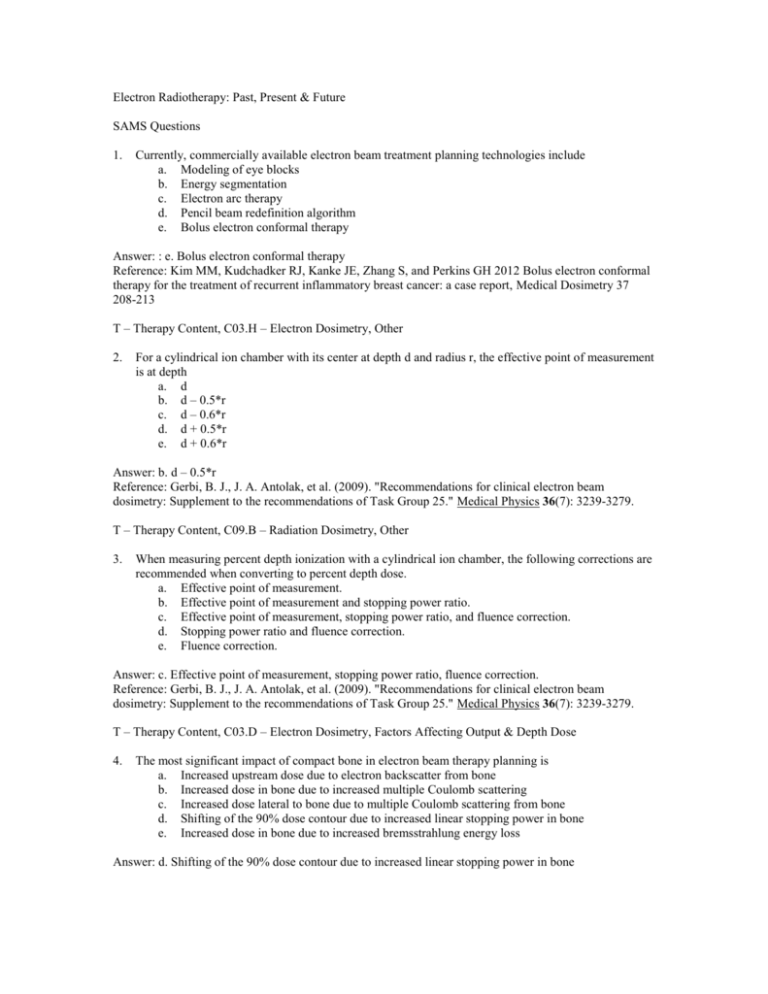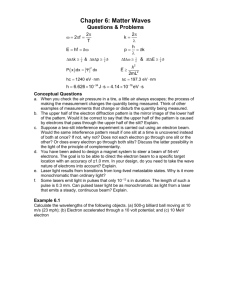Electron Radiotherapy: Past, Present & Future SAMS Questions
advertisement

Electron Radiotherapy: Past, Present & Future SAMS Questions 1. Currently, commercially available electron beam treatment planning technologies include a. Modeling of eye blocks b. Energy segmentation c. Electron arc therapy d. Pencil beam redefinition algorithm e. Bolus electron conformal therapy Answer: : e. Bolus electron conformal therapy Reference: Kim MM, Kudchadker RJ, Kanke JE, Zhang S, and Perkins GH 2012 Bolus electron conformal therapy for the treatment of recurrent inflammatory breast cancer: a case report, Medical Dosimetry 37 208-213 T – Therapy Content, C03.H – Electron Dosimetry, Other 2. For a cylindrical ion chamber with its center at depth d and radius r, the effective point of measurement is at depth a. d b. d – 0.5*r c. d – 0.6*r d. d + 0.5*r e. d + 0.6*r Answer: b. d – 0.5*r Reference: Gerbi, B. J., J. A. Antolak, et al. (2009). "Recommendations for clinical electron beam dosimetry: Supplement to the recommendations of Task Group 25." Medical Physics 36(7): 3239-3279. T – Therapy Content, C09.B – Radiation Dosimetry, Other 3. When measuring percent depth ionization with a cylindrical ion chamber, the following corrections are recommended when converting to percent depth dose. a. Effective point of measurement. b. Effective point of measurement and stopping power ratio. c. Effective point of measurement, stopping power ratio, and fluence correction. d. Stopping power ratio and fluence correction. e. Fluence correction. Answer: c. Effective point of measurement, stopping power ratio, fluence correction. Reference: Gerbi, B. J., J. A. Antolak, et al. (2009). "Recommendations for clinical electron beam dosimetry: Supplement to the recommendations of Task Group 25." Medical Physics 36(7): 3239-3279. T – Therapy Content, C03.D – Electron Dosimetry, Factors Affecting Output & Depth Dose 4. The most significant impact of compact bone in electron beam therapy planning is a. Increased upstream dose due to electron backscatter from bone b. Increased dose in bone due to increased multiple Coulomb scattering c. Increased dose lateral to bone due to multiple Coulomb scattering from bone d. Shifting of the 90% dose contour due to increased linear stopping power in bone e. Increased dose in bone due to increased bremsstrahlung energy loss Answer: d. Shifting of the 90% dose contour due to increased linear stopping power in bone Reference: Hogstrom KR 2004 Electron beam therapy: dosimetry, planning, and techniques Principles and Practice of Radiation Oncology ed C Perez et al (Baltimore, MD: Lippincott, Williams, & Wilkins) pp 252-282 T – Therapy Content, C03.D – Electron Dosimetry, Factors Affecting Output & Depth Dose 5. The most significant impact of patient heterogeneity on lung dose in electron therapy of the post mastectomy chest wall is: a. Increased penetration in lung due to low lung density b. Scatter from an irregularly shaped chest wall surface c. Scatter from closely spaced ribs d. Scatter from the mediastinum in the IMC field to lung e. Increased dose in region of where electron beams of differing energy abut Answer: a. Increased penetration in lung due to low lung density The low density of lung (0.25-0.33) results in isodose surfaces penetrating 3-4 times deeper. The 90%-40% dose falloff in depth is approximately 1 cm, which corresponds to a 3-4 cm penetration in lung. Also, an extra 1.0 MeV of beam energy, if not compensated using bolus, gives an extra 0.5 cm of penetration in water, which corresponds to a 1.5-2 cm of penetration in lung. Reference: Hogstrom KR 2004 Electron beam therapy: dosimetry, planning, and techniques Principles and Practice of Radiation Oncology ed C Perez et al (Baltimore, MD: Lippincott, Williams, & Wilkins) pp 252-282 T – Therapy Content, C03.D – Electron Dosimetry, Factors Affecting Output & Depth Dose 6. Consider a PTV having a 5-cm diameter circular cross section and a maximum depth of 4 cm. For the distal 90% dose surface to contain the PTV, which of the following are the best initial estimates for beam energy (Ep,o) and field size? a. 12 MeV, 5-cm diameter field b. 12 MeV, 6-cm diameter field c. 12 MeV, 7-cm diameter field d. 13 MeV, 6-cm diameter field e. 13 MeV, 7-cm diameter field Answer: e. 13 MeV, 7-cm diameter field Ep,o(MeV) 3.3 x 4 cm = 13.2 13 MeV Field diameter 5 cm + 1 cm (L border) +1 cm (R border) = 7 cm Reference: Hogstrom KR 2004 Electron beam therapy: dosimetry, planning, and techniques Principles and Practice of Radiation Oncology ed C Perez et al (Baltimore, MD: Lippincott, Williams, & Wilkins) pp 252-282 T – Therapy Content, C03.A – Electron Dosimetry, Properties of Electron Beams 7. Which of the following is not a clinical basis for skin collimation? a. Sharpening penumbra at ends of treatment area in arc therapy of chest wall b. Improvement of dose in abutted electron beams in fixed beam therapy of chest wall c. Protection of eye in treatment of nose d. Restoration of penumbra under bolus e. Small field for treating eyelid Answer: b. Improvement of dose in abutted electron beams in fixed beam therapy of chest wall In answers a, c, d, and e, skin collimation sharpens the penumbra resulting in improved sparing of normal tissue and structures outside the treatment area. In answer e, skin collimation sharpens the penumbra inside the treatment region making error in placement of the edges of abutting fields leading to larger dose variations (increased or decreased dose) in the abutment region. Reference: Hogstrom KR 2004 Electron beam therapy: dosimetry, planning, and techniques Principles and Practice of Radiation Oncology ed C Perez et al (Baltimore, MD: Lippincott, Williams, & Wilkins) pp 252-282 T – Therapy Content, C03.D – Electron Dosimetry, Factors Affecting Output & Depth Dose 8. Which of the following is the most appropriate use of uniform thickness bolus? a. Placing around nose to remove surface irregularity and increase dose to septum b. Placing in ear canal to protect inner ear from increased dose without bolus c. Placing on chest wall to increase surface dose when using low energy electron beams or arc electron therapy d. Placing on chest wall to conform 90% dose surface to distal chest wall PTV surface e. Placing on lateral head to conform 90% dose surface to distal parotid PTV surface Answer: c. Placing on chest wall to increase surface dose when using low energy electron beams or arc electron therapy Both low energy electron beams and arc electron beams have a low surface dose that can be increased by uniform thickness bolus for chest wall treatments. Answers a and b require shaped bolus shaped to the nose or ear, respectively, to remove surface irregularities. Answers d and e require shaped bolus used in electron conformal therapy. Reference: Hogstrom KR 2004 Electron beam therapy: dosimetry, planning, and techniques Principles and Practice of Radiation Oncology ed C Perez et al (Baltimore, MD: Lippincott, Williams, & Wilkins) pp 252-282 T – Therapy Content, C03.C – Electron Dosimetry, Treatment Planning 9. For total skin electron irradiation using a standard 6-position 12-field (Stanford) technique, the ideal 90% width of the electron beam at the patient plane is a. 40-45 cm. b. 50-55 cm. c. 60-65 cm. d. 70-75 cm. e. 80-85 cm. Answer: c. 60-65 cm. Narrower widths make it very difficult to obtain good superior-inferior uniformity, and larger widths scatter more electrons laterally, reducing the dose per MU for the beam. Reference: Antolak, J. A. and K. R. Hogstrom (1998). "Multiple scattering theory for total skin electron beam design." Medical Physics 25(6): 851-859. T – Therapy Content, C03.G – Electron Dosimetry, Total Skin Electron Beam (TSEB) 10. For a Monte Carlo based dose algorithm, to reduce the average statistical uncertainty in the high dose region from 3% to 1% requires a. the same calculation time. b. 3 times longer calculation time. c. 6 times longer calculation time. d. 9 times longer calculation time. e. 12 times longer calculation time. Answer: d. 9 times longer calculation time The dose calculation time is inversely proportional to the square of the requested statistical uncertainty. Reference: Popple, R. A., R. Weinberg, et al. (2006). "Comprehensive evaluation of a commercial macro Monte Carlo electron dose calculation implementation using a standard verification data set." Medical Physics 33(6): 1540-1551. (and many others) T – Therapy Content, C03.C – Electron Dosimetry, Treatment Planning 11. The primary limitation of the Hogstrom pencil-beam algorithm is due to the a. small-angle scattering approximation. b. central-axis approximation. c. range straggling approximation. d. 2D geometry approximation. e. large-angle scattering approximation. Answer: b. the central-axis approximation. Reference: Hogstrom, K. R. and P. R. Almond (2006). "Review of electron beam therapy physics." Physics in Medicine and Biology 51(13): R455-489. Reference: Hogstrom, K. R. and R. E. Steadham (1996). Electron Beam Dose Computation. Teletherapy: Present and Future. J. Palta and T. R. Mackie. Madison, WI, Advanced Medical Publishing: 137-174. Reference: Brahme, A. (1985). "Current algorithms for computed electron beam dose planning." Radiother Oncol 3(4): 347-362. T – Therapy Content, C03.C – Electron Dosimetry, Treatment Planning







